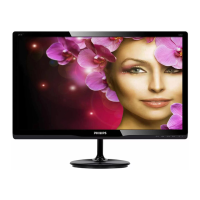
Do you have a question about the Philips 247E4LHAB/57 and is the answer not in the manual?
| Resolution | 1920 x 1080 pixels |
|---|---|
| Panel Type | IPS |
| Aspect Ratio | 16:9 |
| Response Time | 5 ms |
| Brightness | 250 cd/m² |
| Contrast Ratio | 1000:1 |
| SmartContrast | 20, 000, 000:1 |
| Display Colors | 16.7 million |
| Signal Input | VGA, DVI-D, HDMI |
| Built-in Speakers | Yes |
| VESA Mount | 100 x 100 mm |
| Backlight Type | LED |
| Viewing Angle | 178° (H) / 178° (V) |
| Scanning Frequency | 30 - 83 kHz (H) / 56 - 75 Hz (V) |
| Screen Size | 23.6 inches |
General warnings and safety precautions for operating, maintaining, and handling the monitor.
Detailed technical specifications for picture, display, connectivity, and convenience features.
Illustrates the main components and their connections within the monitor.
Instructions for turning the monitor on/off and adjusting picture settings via controls.
Details the On-Screen Display (OSD) structure and navigation for settings.
Pin assignments for D-sub, HDMI connectors, and input signal details.
Lists maximum and recommended resolutions and preset modes for optimal display.
Explains the policy for pixel and sub-pixel defects and acceptable levels.
Shows the block diagram for the scaler board, detailing its inputs and outputs.
Block diagram for the power and USB board, illustrating its main functional blocks.
Provides the schematic diagram for the scaler board, including input and interface connections.
Presents the schematic diagram for the power board, detailing its components and layout.
Shows the schematic diagram for the key board, including touch pad and LED connections.
Visual layout of components on the scaler, power, and key boards for identification.
Illustrates how the panel, key board, and speakers connect to the scaler board.
Highlights major components on the scaler board such as Scaler IC, Flash ROM, and connectors.
Provides step-by-step instructions for removing the monitor's bezel, rear cover, and scaler board.
Details the process of removing the monitor's base or stand.
Flowcharts for diagnosing and resolving common issues like no power, no video, dim image, or color problems.
Lists necessary materials, software, and connection setup for the ISP process.
Details on loading firmware files, programming, and checking the FW version.
Provides troubleshooting steps for common issues encountered during the ISP process.
General information on DDC data re-programming and EDID file management.
Steps to launch the ISP tool, load EDID data, and verify the process.
Troubleshooting tips for issues encountered during the EDID writing process.
Lists calibration tools, installation, and detailed steps for adjustment and color temperature confirmation.
Exploded view diagrams showing the assembly for different monitor models.
A comprehensive list of recommended and spare parts with PCM codes and descriptions.
Lists key features and specifications of the monitor, including resolution and connectivity.
A table summarizing models, inputs, and features for quick comparison.
Defines test conditions, brightness uniformity, and color temperature adjustment procedures.
Details cosmetic aspects, plastic materials, tooling, and housing texture/gloss requirements.
Specifications for the tilt/swivel base, Kensington lock, and labels.
Standards for transportation packaging, testing, and handling procedures.
Defines operating and storage conditions, including temperature, humidity, and air pressure.
